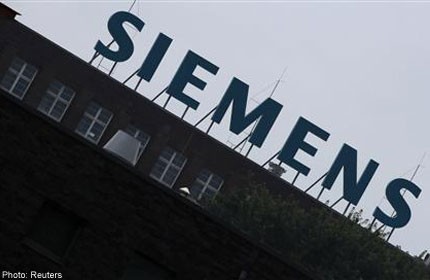In leaving, Siemens CEO seeks to take down chairman


FRANKFURT - Siemens CEO Peter Loescher, whose departure was announced after he issued profit warnings that wrecked the share price of one of Germany's largest industrial conglomerates, may drag the man who hired him down with him, a newspaper reported on Monday.
In what is quickly shaping up to be one of the most dramatic corporate battles in Germany in years, German daily Sueddeutsche Zeitung cited company sources as saying Loescher was willing to resign only if supervisory board chairman Gerhard Cromme also leaves.
A spokesman for Siemens denied Loescher wants Cromme to go down with him. Loescher did not comment on the report.
Cromme, who hired the smooth-talking Austrian Loescher six years ago, lost his job as chairman at steelmaker ThyssenKrupp earlier this year.
Siemens said in a tersely worded statement on Saturday that Loescher would be leaving the company four years before his contract expires. Two people familiar with the matter told Reuters the majority of the 20-member supervisory board favoured fiance chief Joe Kaeser as a replacement for Loescher, who has failed to deliver on his promises of growth and profitability.
The turmoil at the helm of Siemens, Germany's No. 2 company by market value and a bastion of its manufacturing sector, erupted after the company issued its second profit warning this year, sending its shares plunging 8 per cent.
Shares in Siemens rose as much as 2.3 per cent in early trade on Monday but were flat at 1200 GMT. The share price is still up 24 per cent on a year ago. Some investors believe Siemens veteran Kaeser, if named, could turn the company around.
"Kaeser's experience and detailed knowledge of the company make him suitable to succeed Loescher, and we appreciate the breadth of his qualification and experiences," Commerzbank analyst Ingo-Martin Schachel said.
Others said they expected that Kaeser would quickly tighten the reins on costs at Siemens - whose products range from gas turbines to fast trains and ultrasound machines - and sell more non-core businesses such as those that make rail technology or healthcare software.
Loescher and Kaeser have repeatedly said they worked well together, though Kaeser has been taking the lead at investor conferences, laying out details of Siemens' business while his CEO relied more heavily on broad comments.
When asked in 2012 about rumours of friction at the top, Kaeser said they complemented each other like "light and dark".
FAILED STRATEGY
Loescher has in the past promised the company would grow faster than rivals such as ABB, General Electric and Philips.
But bungled acquisitions, charges for project delays and a focus on top-line growth have caused Siemens to fall behind.
Loescher announced a plan last year to cut 6 billion euros (S$10 billion) in costs over two years and lift core operating profit margin to at least 12 per cent from 9.5 per cent by 2014.
Last week Siemens rattled shareholders by abruptly abandoning its margin target in a brief statement that left investors clamouring in vain for more information. Two days later, Siemens said its supervisory board would decide at a meeting on Wednesday on CEO Loescher's early departure.
Ingo Speich, a fund manager at Union Investment, criticised Siemens for announcing that Loescher would be leaving before the supervisory board had even taken its vote.
"Infighting just unnecessarily worsens the problems at Siemens. This is not good corporate governance," he said.
On Thursday, Siemens is expected to report a 23 per cent drop in quarterly core profit.
The company's failure to keep up with rivals has caused investors to favour companies that were faster to slash their cost base and focus on profitable business rather than on increasing revenue.
Siemens trades at 11.6 times estimated 12-month forward earnings, at a discount to ABB and General Electric, which trade at multiples of 13.8 and 14.1, according to StarMine data.